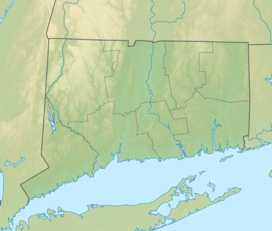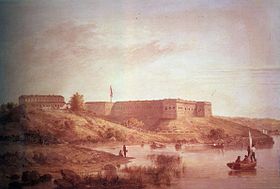|
Fort Trumbull
HistoryIn 1775, Governor Jonathan Trumbull recommended building a fortification at the port of New London to protect the Connecticut government's seat. The fort was built on a rocky point of land near the mouth of the Thames River on Long Island Sound; it was completed in 1777 and named for Governor Trumbull, who served from 1769 to 1784. It was attacked in 1781 during the American Revolutionary War and was captured by British forces under the command of Benedict Arnold.[3][4][5] Arnold's raidBenedict Arnold had betrayed his country by this time, and he was serving as a brigadier general in the British Army when he led a raid on Groton and New London, Connecticut, on September 6, 1781. Two bodies of troops were landed on either side of the mouth of the Thames River and marched towards Fort Trumbull in New London and Fort Griswold in Groton. Fort Trumbull fell after slight resistance, but about 150 Connecticut militiamen made a stand at Fort Griswold in the Battle of Groton Heights. The British were finally able to enter the fort, and militia commander Lieutenant-Colonel William Ledyard offered his sword to Loyalist officer Major Bromfield as a token of surrender. According to contemporaneous accounts, Bromfield took the sword from Ledyard and drove it through him, and Arnold's men proceeded to show no quarter to the remaining American troops. Eighty-five militiamen were killed, and the others were severely wounded, taken prisoner, or managed to escape. After capturing both forts, Arnold's troops burned New London and returned to their ships.[6] An account of the battle published in a Philadelphia newspaper follows:
19th century The fort was repaired around 1808, then redesigned and rebuilt in 1812 to meet changing military needs under the second system of US fortifications. First, a redoubt was built at the site to defend against a possible British attack. Secretary of War Henry Dearborn's report on fortifications for December 1811 describes the fort as "an irregular enclosed work of masonry and sod, mounting 18 heavy guns [with] a brick barracks for one company".[8] The present fortification replaced the older fort, and was built between 1839 and 1852 as a five-sided, four-bastion coastal defense fort. It could accommodate 42 guns on the seacoast fronts, 10 additional guns in two flanking batteries outside the fort, and flank howitzers in bastions for close-in defense.[9] The new fort was built under the supervision of Army engineer George Washington Cullum, who later served as superintendent of the United States Military Academy at West Point, New York. During the American Civil War, Fort Trumbull served as an organizational center for Union troops and headquarters for the 14th US Infantry Regiment. Here, troops were recruited and trained before being sent to war. Fort Trumbull was briefly commanded by John F. Reynolds, who rose to the rank of major general and was killed at the Battle of Gettysburg in 1863. From 1863 to 1879, Ordnance Sergeant Mark Wentworth Smith was assigned to Fort Trumbull and served as the caretaker of Fort Griswold, which was an un-garrisoned sub-post of Fort Trumbull across the Thames River in the town of Groton. Among other duties, he maintained a vegetable garden to help feed the soldiers at Fort Trumbull. Smith was born in New Hampshire in 1803 and enlisted in the Army on January 27, 1827, at age 23. He was wounded in action at the Battle of Chapultepec during the Mexican War. He was allowed to serve on active duty in the Army until he died in 1879 at age 76. He was the oldest enlisted man to serve on active duty in the United States Army in the 19th century.[A] Sergeant Smith is buried in the Colonel Ledyard Cemetery in Groton. In the late 1800s, Fort Trumbull was modified to accommodate 15-inch and 10-inch Rodman smoothbore guns and 8-inch converted rifles. Two 8-inch converted rifles are still in a restored firing position at Fort Trumbull. 20th centuryCoast Guard Academy After the Civil War, Fort Trumbull was improved by having more modern artillery pieces installed. In the early 1900s, several more modern Endicott era fortifications were built to defend Long Island Sound as the Harbor Defenses of Long Island Sound, including Fort Mansfield in Watch Hill, Rhode Island, Fort H.G. Wright on Fishers Island, and Fort Michie on Great Gull Island. Fort Trumbull served as the headquarters of these forts until it was turned over to the Revenue Cutter Service (later renamed the Coast Guard) in 1910 for use as the Revenue Cutter Academy, which was renamed the United States Coast Guard Academy in 1915. The academy moved to its current location about two miles up the Thames River in 1932. Education facilityFort Trumbull served as the Merchant Marine Officers Training School from 1939 to 1946 and trained over 15,000 of the Merchant Marine officers who served during the Second World War.[4] One of the Merchant Marine officers trained there was actor Jack Lord, who is best known for playing Steve McGarrett on the popular TV series Hawaii Five-O in the 1960s and 70s.[11] The Fort was the site of a satellite campus of the University of Connecticut from 1946 to 1950, educating war veterans attending college under the GI Bill. Naval Underwater Sound LaboratoryDuring World War II, Fort Trumbull hosted an office of Columbia University's Division of War Research, which developed passive sonar systems. By 1946, this was consolidated with Harvard University's Underwater Sound Laboratory at Fort Trumbull.[12] A result of this work was that Fort Trumbull was the location for the Naval Underwater Sound Laboratory from 1946 to 1970, which developed sonar and related systems for US Navy submarines. In 1970, the Sound Laboratory was merged with the Naval Underwater Weapons Systems Center (NUWS) to form the Naval Underwater Systems Center (NUSC) in Newport, Rhode Island.[4] Work continued at both locations until the facility at Fort Trumbull was finally closed in 1996, marking the end of almost a century and a half of Fort Trumbull's service as a federal military facility. State park After a redevelopment period lasting several years, Fort Trumbull was opened as a state park in the year 2000. Exhibits include informative markers, cannon and artillery crew displays, and gun emplacements. The interior features restored 19th-century living quarters and a mock laboratory furnished to resemble a 1950s era office facility. The park also offers a large fishing pier and is a site for concerts and other special events. The main fort is open to the public and has an elevator to access the upper portions of the fort.[3][4]
NotesSee also
References
Sources
External linksWikimedia Commons has media related to Fort Trumbull.
Information related to Fort Trumbull |
||||||||||||||||||||||||||||||||||||||



